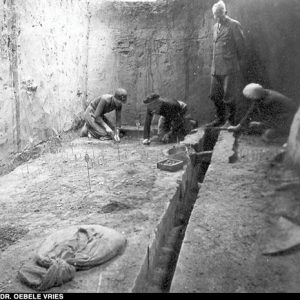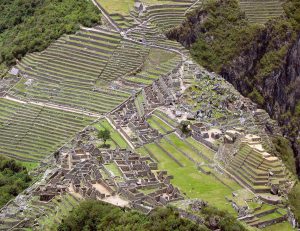Today’s post comes from James Olney, Class of 2020 and Art Center Student Docent.
Last November, I brought two of my friends into Manhattan to see the retrospective of painter Agnes Martin’s work at the Guggenheim
Nationalistic Nazi Archaeology
Everything the Nazis did can be attributed to them trying to prove that the Aryan race existed. To convince the educated and to further authenticity, party leaders actively targeted other educated people to provide this evidence. Thus, a variety of scholarly fields such as archaeology were turned into a source of informational aid to benefit Nazi ideologies.
Tenants of Nazi Archaeology
The Nazi researchers conducted all of their work under a certain nationalistic framework. They referred to the framework as the Five Tenants. The tenants are as follows:
- Kulturkreise (culture circles), which states that recognition of an ethnic region only comes from the materials excavated at the site.
- The social diffusion theory, which states that ideas are spread from the most advanced culture to the least advanced culture.
- Deutsche Reinheit (the pure German man), which states that Germans were “pure Aryans.”
- Weltanschauungswissenschaften (world view sciences), which says that culture and science are one and they carry race-inherent values.
- Secrecy. The last tenant was secrecy because these ideas were never formally released to the public.
Hitler’s Archaeologists
The elite Nazi research group that upheld the five tenants was formed in 1935, before the major outbreak of World War II. Led by Gestapo and SS officer Heinrich Himmler, the Ahnenerbe was designed with the goal of unearthing new evidence of the accomplishments of the great Germanic ancestors. The name Ahnenerbe roughly translates to “something inherited from the forefathers”. As evident from just the name, the archaeologists were working under extreme nationalistic ideas. This nationalism led to extremely far-fetched historical conclusions. For example, the young researcher Assien Bohmers claimed he could trace Nordic origins all the way back to the Paleolithic era in Germany. When combined with the ideas of Kulturkreise and social diffusion, this would objectively name German Aryans as the dominant culture and entitle them to huge portions of already owned land.
Battling Nationalistic Archaeology
The construction of a national past should not be made at the expense of abandoning the knowledge of our shared past. A national past should also not be simply created for the purpose of future goals; all cultures and traditions should be recognized as a worthy study. The Ahnenerbe twisted their research in order to twist the history of Germany so the Nazis could have justified actions. If archaeologists today can move forward while trying to free their research from any social theories built into a society (such as the five tenants), then the history will be reported accurately and honestly. It is up to archaeologists today to respect the past in order to respect the future.
Other Readings
- http://anthropology.msu.edu/anp203h-ss14/2014/04/01/nazi-archaeology/
- https://www.jstor.org/stable/pdf/2802176.pdf
References
Unearthing Treblinka: Archaeology as a Tool to Restore Memory
During WWII, over 900,000 Jewish deportees were killed and buried at the Treblinka death camp in Poland. The Nazis left Treblinka in 1943, but not before knocking down all buildings and leveling the earth. They then built a farmhouse on the stripped land, planted trees, and installed a Ukrainian farmer on the area. An investigation of German crimes in 1946 found the remains of burnt posts, foundations of a building and well, and sections of paved road. The investigation also discovered human remains buried in the ground. However, none of this information alluding to the site of a mass murder was reported to the public. Despite witness testimonies supporting the concept of a mass grave at Treblinka, the reported lack of physical evidence failed to produce further investigation.
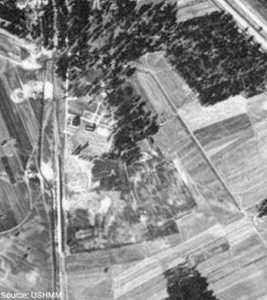
This aerial photo from 1943 following Treblinka’s closure shows an empty area of land, apart from the farmhouse at top left. Archaeologists have found that the farmhouse was in fact constructed using bricks from the dismantled gas chambers.
These German crime investigation reports remained the most complete studies of Treblinka until 2010, when a team of archaeologists began working on the area. In order to respect Jewish law and tradition banning the exhumation of the dead, they did not excavate the area. Instead, the team uses noninvasive technologies such as aerial photography, ground-penetrating radar, GPS, and lidar. These methods have identified the traces of probable undressing barracks, gas chambers, and burial/cremation pits. One of the burial pits found was recorded as 26 meters long, 17 meters wide, and 4 meters deep. Five more pits of similar sizes are located nearby, each revealing the massive scale of the atrocities committed at the site.
Surface survey has also found items on the ground surface at Treblinka, including human bone, which correlates to witness testimonies of improvised cremation methods. According to survivors, the camp did not decide to cremate bodies until it had been open for several months, and due to a lack of a purpose-built crematorium, they began burning bodies on makeshift pyres. These cremation results would not have eradicated bone, which has resulted in the presence of bone fragments at the site. Personal and everyday items have also been found at the site by means of surface survey.

A photo of the current memorial at Treblinka commemorating the 900,000 Jewish people who were killed at the site.
Treblinka was not the only death camp left empty by the Nazis. Two other camps in Poland, Bełżec and Sobibór, were also razed completely after their closures. For this reason, these camps have receded into the historical background compared to Auschwitz, which was discovered with gas chambers still standing and thousands of prisoners still alive. The Nazis also destroyed all written records, leaving the only source of evidence of the mass murders at these sites as witness testimony. Until this project, it seemed that Treblinka and its memories had been wiped off the face of the earth. The work of the archaeological team at this site demonstrates the power of archaeology to at least partially bring back lost knowledge and memory. The team is planning on long-term collaboration with the Treblinka museum in order to continue unearthing new physical evidence at the site and to allow the victims to be properly commemorated.
Sources:
http://www.bbc.com/news/magazine-16657363
http://www.sapiens.org/archaeology/the-darkest-truths/
https://www.scientificamerican.com/article/unearthing-the-atrocities-of-nazi-death-camps/
Images:
http://www.bbc.com/news/magazine-16657363
http://www.sapiens.org/archaeology/the-darkest-truths/
Further Reading:
http://www.smithsonianchannel.com/shows/treblinka-hitlers-killing-machine/0/3403868
http://www.tandfonline.com/doi/abs/10.1179/1574077312Z.0000000005
Impact of the Nile River on Ancient Egypt
In the thousands of years after the end of the last Ice Age, North Africa had a much wetter climate than it does today. Over time, the climate became drier as the wetlands turned into the Sahara Desert we know today. The land became dry and difficult for human societies to live in. In the midst of the desert, however, was a flowing river called the Nile.
The Nile supported and allowed life to thrive in the grueling climate. The earliest inhabitants along the river found that the river provided many sources of food, and more importantly, discovered an annual 6 month period where the Nile flooded. The brown layer of silt that the Nile left when it receded was full of nutrients that allowed for farming to occur. Through the use of irrigation canals, agriculture was born which paved the way for the emergence of Egyptian civilization.
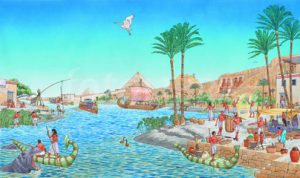
This painting depicts the vitality the Nile River brings to the arid climate. Without it, Egyptian civilization could not have existed.
The inhabitants utilized the Nile to adapt to the changing environment. Instead of roaming the land, they saw the opportunity the Nile provided them through agriculture. Similar to how the Mayans developed Neolithic techniques through maize, beans, and squash in the tropical climate of Guatemalan rainforests, early Egyptians were able to grow wheat, beans, and cotton on the banks of the Nile. By determining when the Nile flooded, the river proved to be a sustainable way to live life.
The flooding of the Nile was not a perfect occurrence. This gave rise to the belief in the gods and a highly stratified social structure. At the top of the social structure were gods such as Ra and Osiris because the Egyptians believed that they controlled the universe. The Egyptians tried their best to please the gods because if they were happy, then the Nile would flood producing an abundance of crops and preventing famine. After the gods came the pharaohs in social status. The Egyptian people believed the pharaoh to be a god in mortal form. They had absolute power over the dominion which required protection through the help of government officials and soldiers. The rest of the people’s status went in the order of scribes, merchants, artisans, farmers, and finally slaves.
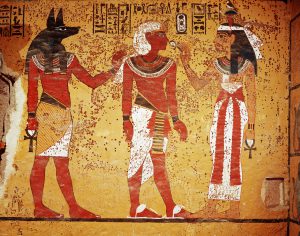
This wall painting depicts the King Tutankhamen with Egyptian gods Anubis and Nephthys. King Tutankhamen ruled from 1333- 1323 BCE.
This social stratification was necessary for a civilization as large as ancient Egypt to function. Slaves were utilized to build infrastructure, farmers produced the food for the society, and the other social levels contributed by either governing, defending, or producing commodities for the civilization. Social mobility was possible in ancient Egypt though. Sending sons to schools to learn how to read and write could make it possible for them to become a scribe, boosting social status.
Ancient Egyptian civilization was created and greatly influenced by the Nile River. The flooding of the Nile was sustainable but not perfectly reliable, creating the belief in gods and social stratification. The Nile River provided sustenance to Egypt for around 3000 years. In 332 BC, Alexander the Great conquered Egypt and Ptolemaic period of Macedonian rule began.
Sources:
http://www.ushistory.org/civ/3b.asp
http://www.ushistory.org/civ/3a.asp
http://www.timemaps.com/ancient-egyptian-history-3500bc
Images:
http://egyptiansyear4.weebly.com/the-uses-of-the-river-nile.html
Further Readings:
http://www.ancient.eu/article/997/
http://www.livescience.com/32616-how-were-the-egyptian-pyramids-built-.html
Environmental Adaptation of Ancient Incan Cities
The ancient Incan civilization first began developing settlements in coastal and highland regions of the Andes mountain range in Peru between 3000-1800 BC. The empire started and was centered in the capital city of Cuzco. Despite a lack of many modern advances such as the wheel, powerful draft animals, currency, or even an advanced written language, the Incas developed very advanced technologies and systems to adapt to their environments. An elaborate road system connected the distant mountain cities, and the aqueduct system in place greatly impressed the Spanish upon discovery. The advanced highway and hydraulic systems provided the framework for a successful empire.
The network of roads connecting the empire stretched across nearly 25,000 miles. The sophisticated roads were were constructed with very limited resources, and rope suspension bridges were built to impressively cross ravines.The impressive aqueduct system of the Incan empire functioned to irrigate agricultural terraces and bring fresh drinking water into the cities. The aqueducts, often build on the sides of mountains, collected water from the mountains for distribution elsewhere. The same aqueducts are still used extensively today. The stepped agricultural terraces created more space to grow crops than was available in the valleys. Additionally, the large surrounding mountains blocked sunlight from the valleys; the terraces insured more direct sunlight for more of the day. The terraces also allowed for better control of water for irrigation. The systems of irrigation protected against flooding and allowed the Incas to reliably produce long term food supplies at an extremely efficient rate. People around the world continue to visit the beautiful terraces at Machu Picchu. This site was built as a retreat for the Incan emperor. Tourists can see how the aqueducts transport water because the system is still functional today.
The agricultural innovations of the Inca serve as a model for successful adaptation of cities to their environments and conditions. The Incas utilized their mountainous surrounding to maximize the efficiency of their agriculture and irrigation systems. These advances boosted agriculture not only for the Incan civilization, but the Sacred Valley of the Incas continues to be Peru’s most productive region. While complete sustainability may be nearly impossible to achieve, the Incas of Peru successfully adapted to their conditions in a lasting way that improved the success of their cities for generations to come. The study of their innovation and adaptation can be applicable to modern cities and for developing systems of sustainability in our modern society.
Sources:
The Incas: History of the Andean Empire
The Incan Aqueducts- Irrigation Systems
The Inca Agricultural Terraces
Photos:
For Additional Reading:
National Geographic Investigates: Ancient Inca, Archaeology Unlocks the Secret’s of Inca’s Past


